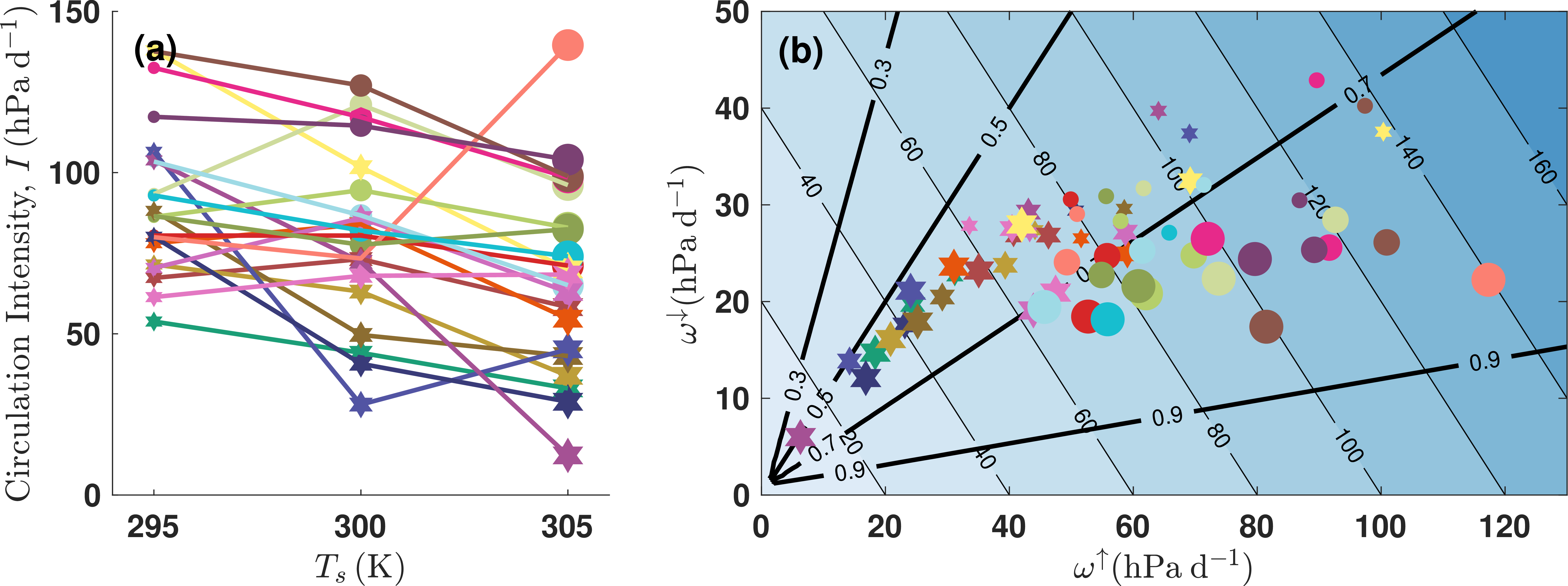Silvers, Levi G., and Reed, Kevin A. and Wing, Allison A., : The Response of the Large-Scale Tropical Circulation to Warming. Journal of Advances in Modeling Earth Systems, 15, e2021MS002966 , https://doi.org/10.1029/2021MS002966
Key Points
Plain Language Summary
Tropical large-scale overturning circulations are expected to weaken with warming. This weakening is the result of precipitation increasing at a slower rate than the atmospheric water vapor. Because precipitation and water vapor are important measures of how energy flows through the atmosphere it is important to understand how they will respond to a warming climate. We use two methods to calculate the change of the overturning circulation in 21 different simulations of the tropical atmosphere. This group of 21 models includes high resolution models that resolve cloud systems, and global models with grid-spacing of about 100 km. We show that a weakening circulation that results from increasing atmospheric stability and increased water vapor is a robust result across most models. But across the group of models there is a large range of magnitudes in the response of the circulation to warming. This variability is well explained by the magnitude of the mean upward vertical velocity. Higher resolution models do not have a narrower range of responses. Narrowing this range of responses will depend on developing a better understanding of what drives the variations in atmospheric stability, surface fluxes of latent energy, and relative humidity.
Abstract
Previous work has found that as the surface warms the large-scale tropical circulations weaken, convective anvil cloud fraction decreases, and atmospheric static stability increases. Circulation changes inevitably lead to changes in the humidity and cloud fields which influence the surface energetics. The exchange of mass between the boundary layer (BL) and the midtroposphere has also been shown to weaken in global climate models. What has remained less clear is how robust these changes in the circulation are to different representations of convection, clouds, and microphysics in numerical models. We use simulations from the Radiative-Convective Equilibrium Model Intercomparison Project to investigate the interaction between overturning circulations, surface temperature, and atmospheric moisture. We analyze the underlying mechanisms of these relationships using a 21-member model ensemble that includes both General Circulation Models and Cloud-system Resolving Models. We find a large spread in the change of intensity of the overturning circulation. Both the range of the circulation intensity, and its change with warming can be explained by the range of the mean upward vertical velocity. There is also a consistent decrease in the exchange of mass between the BL and the midtroposphere. However, the magnitude of the decrease varies substantially due to the range of responses in both mean precipitation and mean precipitable water. We hypothesize based on these results that despite well understood thermodynamic constraints, there is still a considerable ability for the cloud fields and the precipitation efficiency to drive a substantial range of tropical convective responses to warming.
Key Figure
(a) Intensity of the large-scale circulation, I, as a function of Ts. (b) Intensity of large-scale circulation (shading, hPa d−1) decomposed into the magnitude of individual components ω↓ and ω↑. Thick black lines represent constant values of the subsidence fraction (0.3, 0.5, 0.7, and 0.9). Circles (stars) indicate General Circulation Models (GCMs) (Cloud-system Resolving Models (CRMs)) and increasing marker size indicates increased values of Ts. All GCMs have been interpolated to a 1 × 1 degree grid and the CRMs have been coarsened to blocks that are (96 km)2.
Acknowledgments
Silvers and Reed acknowledge support from NSF award number 1830729, Wing acknowledges support from NSF award number 1830724. We are grateful to the German Climate Computing Center (DKRZ) where the RCEMIP data is hosted. RCEMIP data is publicly avail- able at http://hdl.handle.net/21.14101/ d4beee8e-6996-453e-bbd1-ff53b6874c0e. We are grateful to all of the RCEMIP contributors for providing the RCEMIP simulations. We thank Catherine Stauffer for providing net radiative cooling profiles in the regions of subsidence. We thank Michael Byrne and Anna Mackie for helpful conversations during the development of this research and Andrea Jenney for an insightful review of the submitted manuscript. The authors would also like to thank two anonymous review- ers for their feedback. High-performance computing support was provided by NCAR's Computational and Information Systems Laboratory through the computer Cheyenne (https://doi.org/10.5065/ D6RX99HX). NCAR is sponsored by the National Science Foundation.
